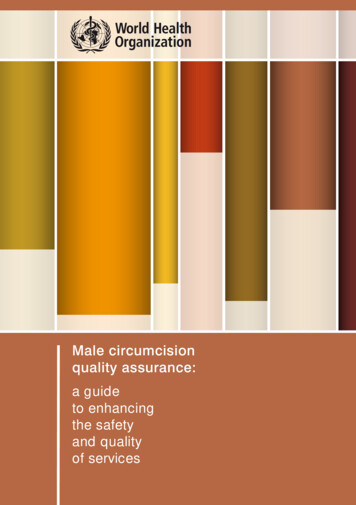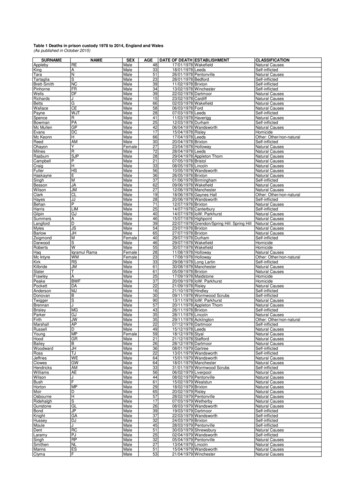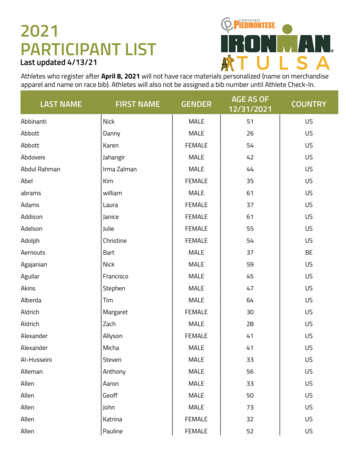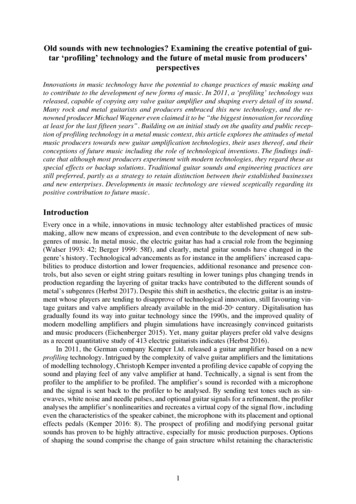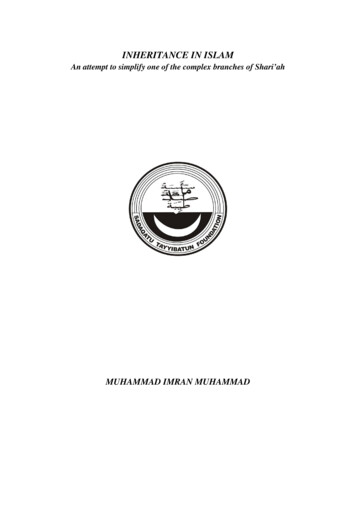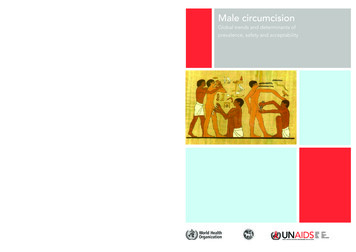
Transcription
Male circumcisionGlobal trends and determinants ofprevalence, safety and acceptabilityUNAIDS20 AVENUE APPIACH-1211 GENEVA 27SWITZERLANDT ( 41) 22 791 36 66F ( 41) 22 791 41 87Department of Reproductive health and ResearchWorld Health Organization20 AVENUE APPIACH-1211 GENEVA 27SWITZERLANDT ( 41) 22 791 2111F ( 41) 22 791 41 N 978 92 4 159616 9
Male circumcision:global trends and determinants ofprevalence, safety and acceptability
IWHO Library Cataloguing-in-Publication DataMale circumcision: global trends and determinants of prevalence, safety and acceptability.« UNAIDS / 07.29E / JC1320E ».1. Circumcision, Male - trends. 2.Circumcision, Male - methods. 3.HIV infections - prevention and control. I.World Health Organization.II.UNAIDS.ISBN 978 92 4 159616 9 (WHO)ISBN 978 92 9 173633 1 (UNAIDS)(NLM classification: WJ 790) World Health Organization and Joint United Nations Programme on HIV/AIDS, 2007All rights reserved. Publications of the World Health Organization can be obtained from WHO Press, World Health Organization, 20Avenue Appia, 1211 Geneva 27, Switzerland (tel.: 41 22 791 3264; fax: 41 22 791 4857; e-mail: bookorders@who.int). Requestsfor permission to reproduce or translate WHO publications – whether for sale or for noncommercial distribution – should be addressedto WHO Press, at the above address (fax: 41 22 791 4806; e-mail: permissions@who.int).The designations employed and the presentation of the material in this publication do not imply the expression of any opinion whatsoever on the part of the World Health Organization concerning the legal status of any country, territory, city or area or of its authorities,or concerning the delimitation of its frontiers or boundaries. Dotted lines on maps represent approximate border lines for which theremay not yet be full agreement.The mention of specific companies or of certain manufacturers’ products does not imply that they are endorsed or recommended bythe World Health Organization in preference to others of a similar nature that are not mentioned. Errors and omissions excepted, thenames of proprietary products are distinguished by initial capital letters.All reasonable precautions have been taken by the World Health Organization to verify the information contained in this publication.However, the published material is being distributed without warranty of any kind, either expressed or implied. The responsibility forthe interpretation and use of the material lies with the reader. In no event shall the World Health Organization be liable for damagesarising from its use.Printed in
ContentsAcknowledgementsAbbreviations and acronymsSummary1SECTION 1. Determinants of male circumcision and global prevalence1.1 Introduction31.2 Determinants of male circumcision31.3 Global prevalence of male circumcision71.4 Regional prevalence of male circumcision91.5 Summary12SECTION 2. Medical indications, clinical procedures and safety of male circumcision2.1 Introduction132.2 The foreskin132.3 Medical determinants of male circumcision142.4 Male circumcision in clinical settings162.5 Male circumcision in non-clinical settings192.6 Summary21SECTION 3. Male circumcision and HIV: Public health issues concerning increaseduptake of male circumcision in sub-Saharan Africa3.1 Introduction223.2 HIV prevention in southern Africa223.3 Acceptability of male circumcision in East and southern Africa223.4 Behaviour change following circumcision263.5 Cost-effectiveness of male circumcision for HIV prevention263.6 Male circumcision and female genital mutilation273.7 Human rights, ethical and legal implications283.8 Summary28SECTION 4. Conclusions29SECTION 5. References30
AcknowledgementsThis report is the result of collaborative work between the London School of Hygiene and Tropical Medicine,the World Health Organization and the Joint United Nations Programme on HIV/AIDS (UNAIDS). Thereport was written by Helen Weiss, Jonny Polonsky, Robert Bailey, Catherine Hankins, Daniel Halperin andGeorge Schmid. We also thank the following for their written comments: David Alnwick, Chiweni Chimbwete,Isabelle de Zoysa, Kim Dickson, Tim Farley, Brian Morris, Inon Schenker and Charles Shey Wiysonge. Layoutby Cath Hamill. Our appreciation also goes to Lon Rahn, Tania Lemay, Mihika Acharya and Constance Kponvifor their assistance.Abbreviations and acronymsAIDSacquired immunodeficiency syndromeCIconfidence intervalFGMfemale genital mutilationHIVhuman immunodeficiency virusJHPIEGOJohns Hopkins Program for International Education in Gynecology and ObstetricsORodds ratioRRrelative riskSTIsexually transmitted infectionUNAIDSJoint United Nations Programme on HIV/AIDSUNFPAUnited Nations Population FundUNICEFUnited Nations Children’s FundWHOWorld Health Organization
Male circumcision: global trends and determinants of prevalence, safety and acceptabilitySummaryMale circumcision is one of the oldest and most common surgical procedures worldwide, and is undertaken for many reasons: religious, cultural, socialand medical. There is conclusive evidence fromobservational data and three randomized controlledtrials that circumcised men have a significantly lowerrisk of becoming infected with the human immunodeficiency virus (HIV). Demand for safe, affordablemale circumcision is expected to increase rapidly,and country-level decision-makers need informationabout the sociocultural and medical determinants ofcircumcision, as well as risks of the procedure, in thecontext of comprehensive HIV prevention programming.Scope of the reviewThe aim of this report is to review the determinants,prevalence, safety and acceptability of male circumcision, focusing on sub-Saharan Africa. In the firstsection, we review the religious, cultural and socialdeterminants of male circumcision and estimatethe global and regional prevalences. In the secondsection, we summarize medical aspects of the procedure, including medical indications for circumcision, surgical methods used and the complicationsof circumcision carried out in clinical and non-clinical settings. The third section focuses on the publichealth implications of the fact that male circumcisionreduces risk of HIV infection, including a summaryof the acceptability of adult male circumcision in currently non-circumcising populations in sub-SaharanAfrica with high incidence of HIV.ResultsApproximately 30% of males are estimated to be circumcised globally, of whom an estimated two thirdsare Muslim. Other common determinants of malecircumcision are ethnicity, perceived health andsexual benefits, and the desire to conform to socialnorms. Neonatal circumcision is common in Israel,the United States of America, Canada, Australiaand New Zealand, and in much of the Middle East,Central Asia and West Africa, but is uncommon inEast and southern Africa, where median age at circumcision varies from boyhood to the late teens ortwenties. In several countries, prevalence of non-religious circumcision has undergone rapid increasesand decreases, reflecting cultural mixing and changing perceptions of health and sexual benefits.There is substantial evidence that male circumcision protects against several diseases, includingurinary tract infections, syphilis, chancroid and invasive penile cancer, as well as HIV. However, as withany surgical procedure, there are risks involved.Neonatal circumcision is a simpler procedure thanadolescent or adult circumcision and has a verylow rate of adverse events, which are usually minor(0.2–0.4%). Adolescent or adult circumcision canbe associated with bleeding, haematoma or sepsis,but these are treatable and there is little evidenceof long-term sequelae when undertaken in a clinical setting with experienced providers. In contrast,circumcision undertaken by inexperienced providerswith inadequate instruments, or with poor after-care,can result in serious complications.Recent studies of acceptability among non-circumcising communities with high prevalence of HIV insouthern Africa were fairly consistent in finding thata majority of men would be willing to be circumcisedif it were done safely and at minimal cost. The primary concerns were around safety, pain and the costof the procedure. Facilitators of acceptability of circumcision were perceived protection from sexuallytransmitted infections (STI), including HIV; improvedgenital hygiene; and improved sexual pleasure ofboth the male and his female partner. Public healthconcerns about increased uptake of male circumcision services focus on safety, acceptability and riskcompensation. To date, there is modest evidenceof risk compensation following adult male circumcision, and care must be taken to embed any malecircumcision provision within existing HIV prevention packages that include intensive counselling onsafer sex, particularly regarding reduction in numberof concurrent sexual partners and correct and consistent use of male and female condoms.ConclusionsThere is increasing demand for male circumcision insouthern Africa and future expansion of circumcisionservices must be embedded within comprehensiveHIV prevention programming, including informedconsent and risk-reduction counselling. Male circumcision can have serious sequelae if carried outin unhygienic settings or by inexperienced providers, and it is therefore essential that existing andfuture demand for circumcision is matched by provision of adequate equipment and training of personnel to conduct safe, voluntary and affordable male1
Male circumcision: global trends and determinants of prevalence, safety and acceptabilitycircumcision. If correctly planned, increased provision of accessible, safe adult male circumcision services could also increase opportunities to educatemen in areas of high HIV prevalence about a varietyof sexual and reproductive health topics, includinghygiene, sexuality, gender relations and the need forongoing combination prevention strategies to furtherdecrease risk of HIV acquisition and transmission.2
Male circumcision: global trends and determinants of prevalence, safety and acceptabilitySECTION 1.Determinants of male circumcision and global prevalence1.1 IntroductionMale circumcision is one of the oldest surgicalprocedures known, traditionally undertaken as amark of cultural identity or religious importance.With advances in surgery in the 19th century, andincreased mobility in the 20th century, the procedure was introduced into some previously noncircumcising cultures for both health-related andsocial reasons. In this section we review the maindeterminants of male circumcision and describe theglobal and regional prevalences of male circumcision today.1.2 Determinants of male circumcisionHistorically, male circumcision has been associated with religious practice and ethnic identity.Circumcision was practised among ancient Semiticpeoples, including Egyptians and Jews (1), with theearliest records depicting the practice coming fromEgyptian tomb work and wall paintings dating fromaround 2300 BC (Figure 1).Figure 1. Ancient Egyptian relief from Ankhmahor,Saqqara, Egypt (2345–2182 BC), representing adultcircumcision ceremonyhttp://en.wikipedia.org/wiki/Image:Egypt circ.jpg1.2.1 ReligionJudaismIn the Jewish religion, male infants are traditionallycircumcised on their eighth day of life, providing thereis no medical contraindication. The justification, inthe Jewish holy book (the Torah), is that a covenantwas made between Abraham and God, the outwardsign of which was circumcision for all Jewish males:“This is my covenant, which ye shall keep, betweenme and you and thy seed after thee: every maleamong you shall be circumcised” (Genesis 17:10).Male circumcision continues to be almost universally practised among Jewish people. For example,almost all newborn Jewish males in Israel (2), anestimated 99% of Jewish men in the United Kingdomof Great Britain and Northern Ireland (3) and 98% ofJewish men in the United States of America are circumcised (4).IslamMuslims are the largest religious group to practisemale circumcision. As part of their Abrahamic faith,Muslims practise circumcision as a confirmationof their relationship with God; the practice is alsoknown as tahera, meaning “purification”. There is nospecific mention of circumcision in the Qur’an (5),and it is only obligatory (wajib) among one of thesix Islamic schools of law (the Shafi’ite school). Theother schools regard the practice as traditional (sunnah) and strongly encourage it. It is also essentialfor a man to be circumcised to lawfully make the hajj(pilgrimage) to Mecca, one of the five pillars of Islamicbelief (6).With the global spread of Islam from the 7th century AD, male circumcision was widely adoptedamong previously non-circumcising peoples. Insome regions, male circumcision was already acultural tradition prior to the arrival of Islam (forexample, among the Poro in West Africa, and inTimor in South-East Asia) (7–9). In other regions,Islam became a major determinant of circumcision. For example, in Rakai District, Uganda, 99%of Muslim men are circumcised, compared with just4% of non-Muslim men (10). However, this is notalways the case, and in nearby Mwanza region ofthe North-west of the United Republic of Tanzania,which has no traditionally circumcising ethnic group,circumcision is not universal among Muslim men(estimated prevalence is 74% among the Sukumaethnic group), suggesting a continuing influence ofthe non-circumcising culture among Muslims in thissetting (11).There is no clearly prescribed age for circumcisionin Islam, although the prophet Muhammad recommended it be carried out at an early age and reportedly circumcised his sons on the seventh day afterbirth (6). Many Muslims perform the rite on this day,although a Muslim may be circumcised at any age3
Male circumcision: global trends and determinants of prevalence, safety and acceptabilitybetween birth and puberty. In Pakistan, for example,the general practice is to circumcise boys born inhospital a few days before discharge, whereas thoseborn outside hospital are circumcised between theages of 3 and 7 years (6). Similarly, in Turkey, Muslimboys are circumcised between the eighth day afterbirth and puberty (12), and in Indonesia, typicallybetween the ages of 5 and 18 years (8).Other religionsWith the major exceptions of Islam and Judaism,religion tends not to be a major determinant of malecircumcision and many religions, including Hinduismand Buddhism, appear to have a neutral stancetowards it.The Coptic Christians in Egypt and the EthiopianOrthodox Christians practise two of the oldest surviving forms of Christianity (5) and retain many ofthe features of early Christianity, including male circumcision (to take one instance, 97% of Orthodoxmen in Ethiopia are circumcised) (13). Circumcisionis not prescribed in other forms of Christianity – forexample, St Paul wrote: “In Christ Jesus neither circumcision nor uncircumcision count for anything”(Galatians 5:6), and a papal bull issued in 1442 bythe Roman Catholic Church stated that male circumcision was unnecessary, “Therefore it strictlyorders all who glory in the name of Christian, not topractise circumcision either before or after baptism,since whether or not they place their hope in it, itcannot possibly be observed without loss of eternalsalvation” (14). Focus group discussions on malecircumcision in sub-Saharan Africa found no clearconsensus on compatibility of male circumcisionwith Christian beliefs (15). Some Christian churchesin South Africa oppose the practice, viewing it as apagan ritual (16), while others, including the NomiyaChurch in Kenya, require circumcision for membership (17). Participants in focus group discussions inMalawi and Zambia mentioned similar beliefs thatChristians should practise circumcision since Jesuswas circumcised and the Bible teaches the practice(18, 19).In some West African countries, circumcision prevalence tends to be lower among those of traditional religion than among Christians (66% vs. 93% in BurkinaFaso, 68% vs. 95% in Ghana) (13). Although religionand ethnicity can be closely correlated, religion canbe a strong determinant within an ethnic group. For4example, among the Mole-Dagbani in Ghana 97% ofMuslims are circumcised, 78% of Christians, 43% ofthose with traditional religion and 52% of those withno religion (13). In Cameroon, circumcision is almostuniversal among all religions except the Animists(79% prevalence), among whom there is one particular ethnic group, the Mboum, who tend not tocircumcise (40%), compared with a circumcisionprevalence of 89% among non-Mboum Animists.1.2.2 EthnicityCircumcision has been practised for non-religiousreasons for many thousands of years in sub-SaharanAfrica, and in many ethnic groups around the world,including aboriginal Australasians (20, 21), theAztecs and Mayans in the Americas (5, 22, 23), andinhabitants of the Philippines and eastern Indonesia(8) and of various Pacific islands, including Fiji (24)and the Polynesian islands (7).Prevalence of circumcision within a country can varydramatically by ethnicity. For example, although anestimated 84% of all Kenyan men are circumcised,the percentage is much lower among the Luo andTurkana ethnic groups (17% and 40%, respectively)(13), and focus group discussions among adult Luomen and women found no knowledge of any history of male circumcision among the Luo in Kenya.Instead, children traditionally had their six lower frontteeth removed at initiation. Similarly, male circumcision is not practised among the Jopadhola, Acholiand other Luo-speaking River-Lake Nilotic groups inUganda and southern Sudan, from where the Luomigrated (25).In the majority of these cultures, circumcision is anintegral part of a rite of passage to manhood, althoughoriginally it may have been a test of bravery and endurance (Figure 2) (26). Circumcision is also associatedwith factors such as masculinity, social cohesion withboys of the same age who become circumcised at thesame time, self-identity and spirituality (27). The association with initiation to manhood is not universal, however, with some ethnic groups, such as the Yoruba andIgbo in Nigeria, circumcising in infancy (21). The ethnographer Arnold van Gennep, in his 1909 work Therites of passage (28), describes various initiation ritesthat are present in many circumcision rituals. Theseinclude a three-stage process: separation from normalsociety; a period during which the neophyte undergoestransformation; and, finally, reintegration into society in
Male circumcision: global trends and determinants of prevalence, safety and acceptabilityFigure 2. Traditional circumcision in Ugandadiscrimination may extend to entire ethnic groups,as in the case of the Luo in Kenya, who do not traditionally practise circumcision and report that theyare often discriminated against by other Kenyansbecause of this (25).1.2.3 Social determinantsSocial desirabilityPhoto permission granted by New Visiona new social role. A psychological explanation for thisprocess is that ambiguity in social roles creates tension, and a symbolic reclassification is necessary asindividuals approach the transition from being definedas a child to being defined as an adult. This is supportedby the fact that many rituals attach specific meaningto circumcision that justify its purpose within this context. For example, certain ethnic groups, including theDogon and Dowayo of West Africa and the Xhosa ofSouth Africa, view the foreskin as the feminine elementof the penis, the removal of which (along with passingcertain tests) makes a man out of the child (29, 30).Ethnicity is thus a major determinant of circumcisionworldwide – for example, in ethnic groups of BendelState in southern Nigeria, 43% of men stated thattheir motivation for circumcision was to maintaintheir tradition (31). In some settings where circumcision is the norm there is discrimination against noncircumcised men. In some cultures, such as the Yaoin Malawi, the Lunda and Luvale in Zambia, or theBagisu in Uganda (18,19, 32), it is unacceptable toremain uncircumcised, to the extent that forced circumcisions of older boys are not uncommon (15).Among the Xhosa in South Africa men who have notbeen circumcised can suffer extreme forms of punishment, including bullying and beatings (29). ThisToday, male circumcision is performed for a rangeof reasons, mainly social or health related, in addition to religion and ethnicity. The desire to conformis an important motivation for circumcision in placeswhere the majority of boys are circumcised. A surveyin Denver, United States of America, where circumcision occurs shortly after birth, found that parents,especially fathers, of newborn boys cited social reasons as the main determinant for choosing circumcision (for example, not wanting him to look different).The main correlate of circumcision status was circumcision status of the father, with 90% of circumcised fathers choosing to circumcise their son, compared with 23% of non-circumcised fathers (33).In the Philippines, where circumcision is almostuniversal and typically occurs at age 10–14 years,a survey of boys found strong evidence of socialdeterminants, with two thirds of boys choosing to becircumcised simply “to avoid being uncircumcised”,and 41% stating that it was “part of the tradition”(34). Social concerns were also the primary reason for circumcision in the Republic of Korea (35),with 61% of respondents in one study believing theywould be ridiculed by their peer group unless theywere circumcised (36).Social desirability may also contribute to the relatively recent uptake of circumcision among the Akanethnic group in Ghana, which traditionally did notelect circumcised men as chiefs. However, in thepast century, male circumcision has become morecommon (37, 38) and the most recent Demographicand Health Survey shows that 99% of Akan menwere circumcised and 83% of Akan men reportedthat circumcision was practised in their community(13). The reasons given for the uptake of male circumcision included social, hygiene, disease prevention, female preference and enhanced sexual enjoyment (39). A further example of recent changingpractice comes from the Sukuma ethnic group in theNorth-west of the United Republic of Tanzania, which5
Male circumcision: global trends and determinants of prevalence, safety and acceptabilityis also traditionally non-circumcising. The word forcircumcision in the Sukuma language is derogatory(njilwa); however, now that boys mix with other ethnic groups at school, the practice is more acceptable, with an estimated prevalence of 21% (11).The desire to belong is also likely to be the main factor behind the high rate of adult male circumcisionsamong immigrants to Israel from non-circumcisingcountries (predominantly the former Soviet Union)(40).with no education, in the lowest wealth quintile andliving in rural areas (13). Circumcision prevalence inEthiopia is universally high (93%) but men are mostlikely to be circumcised if they are in a higher wealthquintile, have at least secondary education and livein an urban area.Figure 3. Prevalence of male circumcision byeducation and wealth quintilesCircumcision prevalence by educationSocioeconomic statusSocioeconomic factors also influence circumcisionprevalence, especially in countries with more recentuptake of the practice, such as English-speakingindustrialized countries. When male circumcisionwas first practised in the United Kingdom in the late19th and early 20th century, it was most prevalentamong the upper classes (41). A study published in1953 found that 74% of private-hospital patients inNew York City were circumcised, compared to 57%of non-private patients (42). A similar associationwas seen in a recent nationwide survey in Australia,which found that the proportion of men circumcisedwas significantly associated with higher levels ofeducation and income (43). In the United States ofAmerica, a review of 4.7 million newborn male circumcisions nationwide between 1988 and 2000 alsofound a significant association with private insurance and higher socioeconomic status (44), whichis likely to reflect the low circumcision prevalenceamong recent immigrants, many of whom, in addition to coming from non-circumcising countries,such as China and Mexico, are more likely to be oflower socioeconomic status. Although circumcisionis uncommon in Thailand, it tends to be associatedwith higher educational and socioeconomic status.In order to make male circumcision more accessible, it was recently added to the procedures coveredunder a flat rate payment scheme for a medical visitor procedure of any type (45).In contrast, the Demographic and Health Surveys insub-Saharan African countries show no consistentassociation with socioeconomic status (Figure 3).For example, in the United Republic of Tanzania,higher rates of circumcision are seen among menwith higher levels of education, of higher socioeconomic status and living in urban areas, whereas inLesotho, circumcision is most common among men6No educationPrimary incompletePrimarySecondary EthiopiaKenyaLesothoMalawiUnitedRepublic ofTanzaniaUganda02040Per cent6080100Circumcision prevalence by LesothoMalawiUnitedRepublic ofTanzania0204060Per centSource: MEASURE DHS (13).80100
Male circumcision: global trends and determinants of prevalence, safety and acceptabilityPerceived health and sexual benefitsOne of the driving determinants in the spread of circumcision practices in the English-speaking industrialized world has been the perception that it resultsin improved penile hygiene and lower risk of infections. These were also the main determinants foundin recent studies of factors determining acceptabilityof male circumcision in sub-Saharan African communities that do not traditionally circumcise (seesection 3.3) (15). A male circumcision service wasestablished at the University Teaching Hospital inLusaka, Zambia, in August 2004, and of the 895 circumcisions that have been undertaken there, 91%of clients requested the procedure because theyconsidered it protective against sexually transmittedinfection (STI), including HIV (46).In a study of newborns in the United States ofAmerica in 1983 (33), mothers cited hygiene asthe most important determinant of choosing to circumcise their sons, and in Ghana, male circumcision is seen as cleansing the boy after birth (27,47). Improved hygiene was also cited by 23% of110 boys circumcised in the Philippines (34); andin the Republic of Korea, the principal reason givenfor circumcision among those who thought it wasnecessary, was “to improve penile hygiene” (78%and 71% respectively in two studies) (36; 48) andto prevent conditions such as penile cancer, sexually transmitted diseases and HIV (48). In NyanzaProvince, Kenya, 96% of uncircumcised men and97% of women, irrespective of their preference formale circumcision, stated their opinion that it waseasier for circumcised men to maintain cleanliness(17). Men participating in focus group discussionsin Botswana, Kenya, Malawi, the United Republic ofTanzania, Zambia and Zimbabwe also believed thatit was easier to keep the circumcised penis clean(11, 17–19, 25, 49–51).Perceived improvement of sexual attraction and performance can also motivate circumcision. In a surveyof boys in the Philippines, 11% stated that a determinant of becoming circumcised was that women liketo have sexual intercourse with a circumcised man(34), and 18% of men in the study in the Republic ofKorea stated that circumcision could enhance sexual pleasure (48). In Nyanza Province, Kenya, 55%of uncircumcised men believed that women enjoyedsex more with circumcised men, and this belief wasa strong predictor of preference to be circumcisedeven after controlling for education, employmentand beliefs about whether circumcision was associated with disease. Similarly, the majority of womenbelieved that women enjoyed sex more with circumcised men, even though it is likely that most womenin Nyanza have never experienced sexual relationswith a circumcised man (17). In the North-west ofthe United Republic of Tanzania, younger men associated circumcision with enhanced sexual pleasurefor both men and women (11), and in WestonariaDistrict, South Africa, about half of men said thatwomen preferred circumcised partners (52). Insouthern Nigeria, the enhancement of sexual performance and reproductive ability was also an important reason given for male circumcision (31).1.3 Global prevalence of malecircumcisionWe have estimated the global prevalence of circumcision among males aged 15 years or over by firstassuming that all Muslim and Jewish males in thisage group are circumcised. Then, using publisheddata from the Demographic and Health Surveys andother sources (13, 53, 54), we estimated the number of non-Muslim and non-Jewish men circumcisedin countries with substantial prevalence of nonreligious circumcision (Angola, Australia, Canada,Democratic Republic of Congo, Ethiopia, Ghana,Indonesia, Kenya, Madagascar, Nigeria, Philippines,Republic of Korea, South Africa, Uganda, UnitedKingdom, United Republic of Tanzania and UnitedStates of America) (Table 1).Using these assumptions, we estimate that approximately 30% of the world’s males aged 15 years orolder are circumcised (Table 2). Of these, aroundtwo thirds (69%) are Muslim (living mainly in Asia,the Middle East and North Africa), 0.8% are Jewish,and 13% are non-Muslim and non-Jewish men livingin the United States of America.This method is likely to underestimate the true prevalence of male circumcision, as we have excludedcircumcision among non-Muslim and non-Jewishmen in heavily populated countries such as Brazil,China, India and Japan where a small proportion ofmen are also circumcised, for medical, cultural orsocial reasons. If we assume that 5% of men aged15 years or above who are not included in the count
the World Health Organization in preference to others of a similar nature that are not mentioned. Errors and omissions excepted, the names of proprietary products are distinguished by initial capital letters. All reasonable precautions have been taken by the World Health Organization
